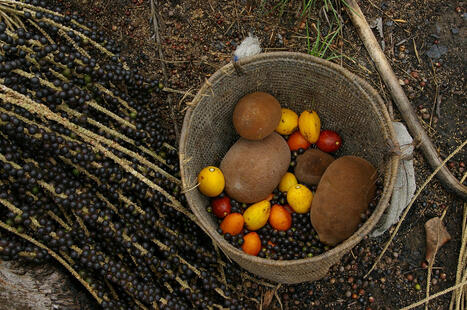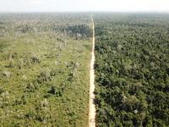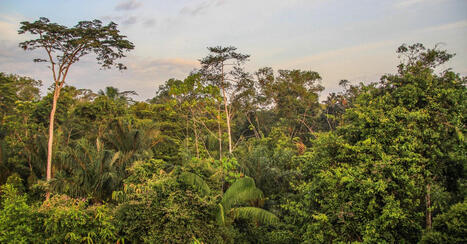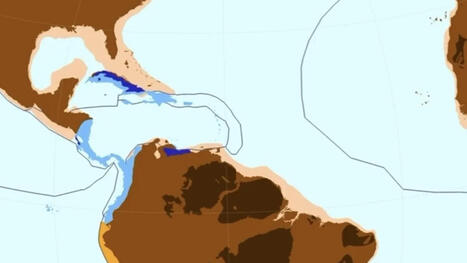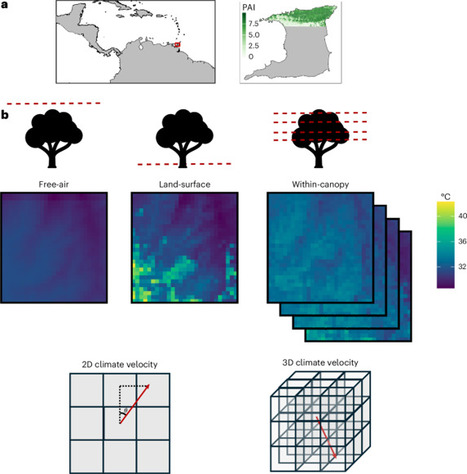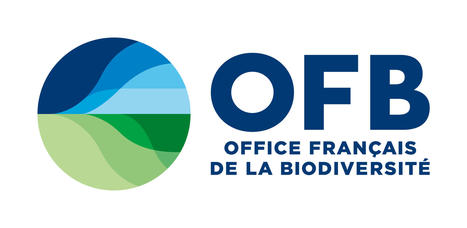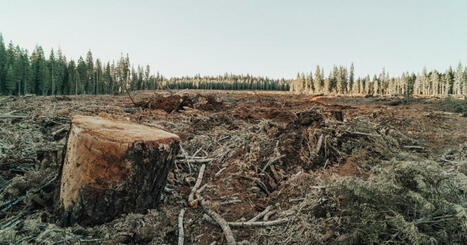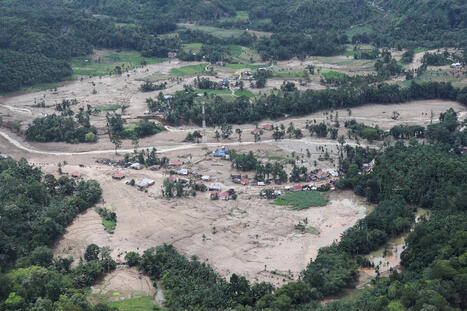 Your new post is loading...
Disponible en libre accès, ce nouveau fascicule analyse la diversité des impacts d’un projet de recherche co-porté par l’IRD sur une agriculture amérindienne en Amazonie du nord-ouest.
La récente COP Climat au Brésil était aussi une « COP des forêts ». Quatre participants à la caravane Iaraçu et à la COP témoigneront du déroulé et des retombées.
Certaines plantes produisent de la chaleur pour faciliter leur reproduction. Une nouvelle étude parue dans Science révèle que, chez les cycadées, ce signal thermique suffit à attirer et orienter les pollinisateurs, suggérant une forme très ancienne de communication entre plantes et insectes.
Déclaration de New York sur les forêts, Moratoire soja au Brésil, Règlement européen contre la déforestation importée, accords « zéro déforestation » en Colombie, etc.: la persistance de la déforestation dans les régions tropicales a conduit à la multiplication d’engagements aussi bien dans les...
Dans les profondeurs de l’Amazonie, des signaux inquiétants s’accumulent. Les arbres semblent atteindre leurs limites physiologiques, tandis qu’un type de climat quasi oublié de l’histoir
Faced with growing evidence of the havoc that climate change and biodiversity loss is wreaking on many parts of our world, pessimists sometimes argue that humanity is simply incapable of the “transformative” change required to ward it off. Human lives are too short, economic interests too entrenched, and politicians beset with too many crises for a sustained, multilateral drive to complete the energy transition and put the planet on a path to sustainability. But that is to ignore a factor that continues to shift the needle toward action and growing confidence that it can bring significant positive change: knowledge of both the problems we face and of existing and emerging solutions.
Le Bassin du Congo, cœur vert de l'Afrique: une contribution de l'ULB à la COP30 L'Université libre de Bruxelles apporte sa contribution à la COP30 à travers la présentation, à Belém, d'un aperçu du Rapport d'évaluation 2025 sur le Bassin du Congo. Parmi ses auteurs, Birgit Ricquier et Olivier Hardy, chercheurs de l'ULB. Le rapport met en lumière l'importance de cette région pour l'équilibre climatique et écologique de l'Afrique et du monde ainsi que la menace qui pèse sur la diversité culturelle locale.
The dramatic increase in scale of ecological restoration required to meet future global targets will require enormous quantities of seed and propagule material. Tropical forests - which are often identified as priority regions for large-scale restoration - often experience substantial fragmentation and degradation, processes which may reduce the availability and genetic quality of seeds and propagules. Hence, trade-offs between cost, quantity, and genetic quality occur due to financial and logistical constraints on collection and production of plant material. Seed provenance, i.e. their ecological origin, may play a crucial role in determining the success of restoration efforts and may be directly influenced by said trade-offs. Here we examined the geographical and environmental ranges over which seeds are collected in three revegetation nurseries in tropical Australia. Our results showed that seed collections from 2012 to 2018 were overwhelmingly ...
La terre face aux machines, une histoire environnementale, épisode : À la tronçonneuse ou par le feu, histoire de la déforestation de l’Amazonie. Une série inédite proposée par France Culture
Une équipe de chercheurs, coordonnée par Melody Philippon de l’Université des Antilles en Guadeloupe, dévoile dans la revue Nature Communications Earth & Environment comment des blocs tectoniques méconnus à l’est de la plaque caraïbe ont façonné la biodiversité des îles des Grandes Antilles. Une avancée majeure dans la compréhension des connexions géologiques et biologiques de la région.
The authors model near-ground and within-canopy microclimates in a tropical montane rainforest. They show that short-distance shifts towards dense vegetation or vertically downwards in canopies reduce velocities, highlighting that structurally complex ecosystems may provide short-term climate...
Le gouvernement de la République Centrafricaine (RCA) a inauguré la journée des Aires protégées de Dzanga-Sangha le 18 novembre 2025, en partenariat avec World Wide Fund (WWF) et l’Institut Helmholtz pour la Santé Unique (HIOH). C’était à travers une cérémonie de haut niveau organisée à Bangui, suivie de célébrations communautaires à Bayanga les 19 et 20 novembre. L’initiative, qualifiée d’historique, vise à promouvoir l’un des paysages de conservation les plus emblématiques d’Afrique.
Protéger la biodiversité ultramarine : ces deux journées de "bilan d'étape" ont permis de mesurer le chemin parcouru, poursuivre le travail de
|
Publié dans le cadre de la COP30 avec la contribution de l'IRD, le rapport 2025 du panel scientifique pour l’Amazonie “Connectivity of the Amazon for a Living Planet”, rassemble les connaissances scientifiques relatives à la connectivité écologique et socioculturelle, considérée comme une stratégie essentielle pour préserver les écosystèmes amazoniens, promouvoir un développement durable et renforcer le bien-être humain et environnemental.
Principale source de caoutchouc naturel, l’hévéaculture est indispensable pour de nombreux secteurs industriels, notamment celui des pneumatiques qui utilise 70 % de la production mondiale. Le Cirad consacre d’importants travaux de recherche à cette filière et lance une feuille de route avec quatre ambitions principales pour la soutenir dans la décennie à venir. Confrontée à de multiples défis sociaux, économiques et environnementaux, l’hévéaculture doit accélérer sa transition vers plus de durabilité.
Conservationists fear up to 11% of Tapanuli orangutan population perished in disaster that also killed 1,000 people
La 9e session de la Réunion des Parties (MOP9) de l'Accord sur la conservation des oiseaux d'eau migrateurs d'Afrique-Eurasie (AEWA) s’est tenue du 11 au 14 novembre 2025 à Bonn, en Allemagne.
La COP20 de la Cites s'est refermée ce vendredi 5 décembre. La Convention sur le commerce international des espèces de faune et de flore sauvages menacées d'extinction est un organisme majeur pour non…
As tropical forests experience chronic drying and more extreme droughts due to climate change, some plants are adapting by growing longer root systems to reach water deep within soils, according to a study published in November in New Phytologist.
Comment fonctionne l’écosystème de la forêt amazonienne de Guyane ? Est-il un puits de carbone ou au contraire est-il émetteur ? Qu’est-ce qui fait qu’un système capte et stocke du carbone ou au contraire en émet ?
RDUE, 4 lettres dont on n’a pas fini d’entendre parler et qui suscitent maintes récriminations, tant au sein de l’UE qu’hors de ses frontières...
Le gouvernement indonésien a reconnu qu’il fallait «absolument empêcher la destruction des forêts», essentielles pour contenir les pluies exceptionnelles apportées par le réchauffement climatique.
In Ghana, the degradation of wetlands is widespread and many are in poor condition.
Les forêts de plaine et de montagne du parc national de Kahuzi-Biega (KBNP), dans l'est de la République démocratique du Congo, ont fait l'objet d'une étude visant à comprendre leur écologie.L’étude a été menée par une équipe de chercheurs de la République démocratique du Congo, et feu Sylvie...
En République centrafricaine, au cœur du Bassin du Congo... La Basse-Lobaye est une réserve de près de 3 000 kilomètres carrés : un véritable joyau de biodiversité, recouvert en grande partie par une…
|




 Your new post is loading...
Your new post is loading...
